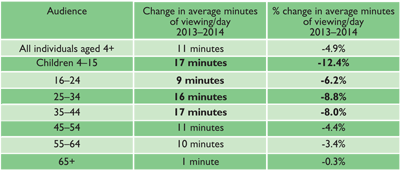The annual report on the UK's media habits reveals a steady increase in the use of video-on-demand services, smartphones and mobile online behaviour through 4G.
This post is by Victoria Stevens, Consumer Insights Director at MEC.
Ofcom's Communications Market Report is an annual account of media consumption, technology adoption and digital proficiency in the UK. Highlights of the latest edition are:
Traditional TV viewing is in decline
In 2014, the average number of minutes of broadcast television watched on a television set fell 4.9% year on year. Viewing diminished across all age groups with significant proportional declines among children aged 4-15 (-12.4%), adults aged 25-34 (-8.8%) and 35-44 (-8.0%). Among the over-65s, viewing dropped the least – this age group still spends 82% of their viewing time watching traditional TV.
Various explanations concerning the decline are in play, such as reduced events programming compared to previous years, increased use of different devices to watch content, rising employment and the weather. According to BaRB data, approximately half of the fall in viewing may be attributed to 8-28 day time-shifted viewing and the consumption of 'unknown' content on TV sets through, for example, smart TV apps and video-on-demand (VoD) facilities. Almost 60% of adults claim to have used at least one VoD provider in the past 12 months and viewing to VoD services represents 8% of total UK adult viewing (13% among 16-24 year-olds).
The adoption of VoD services is steadily increasing – Ofcom's consumer research shows 33% of respondents claiming to use services such as BBC iPlayer, ITV Player and All4 (formerly 4oD) more than they did a year ago, resulting in a 26% gain in viewership to non-subscription VoD services. In the same study, 15% of respondents claim to use services such as Netflix and amazon Prime Instant Video more than they did a year ago, resulting in a 8% increase in viewership to subscription VoD services with the most popular reason being the attraction of a back-catalogue of films.
Despite the challenges posed, television endures – the volume of people watching television each week increased from 53.9 million to 54.1 million viewers year-on-year.
Audience Change in average minutes % change in average minutes of viewing/day of viewing/day 2013–2014 2013–2014

Source: BARB, network, total TV. Average minutes of viewing/day. Note: Bold text in table indicates above-average decline
Smartphones become the device of choice
Smartphone penetration among adults has increased by 27 percentage points since 2012, making smartphones the most widely-owned internet-enabled device (66%) along with laptops (65% of households).
The smartphone is now considered the 'most important' device for connecting to the internet. This year, 33% of consumers identified the smartphone as their primary digital device, with 30% choosing their laptop, compared with 23% and 40% respectively in 2014.
Young people have a higher affinity towards their mobile phones, being 10 times as likely as older people to say that they would miss this device most if it were taken away. In comparison, just 6% of those aged 55+ said their mobile phone was the device they would miss most, while 57% of this age group cited the TV set. This may be related to variation in content types preferred by different age groups – smartphones are twice as likely to be used for watching short video clips (42%) than for watching full-length programmes (21%).
The rise of 4G
30% of UK adults claim to have access to 4G, an increase of 28 percentage points since 2014, representing 45% of all UK smartphone users.
Interestingly, 4G users behave substantially differently to smartphone owners without 4G access, showing a higher propensity to go online often, to partake in data-heavy processes and to be more attached to their devices. Audiovisual consumption on smartphones increases from only 40% among those without 4G access to 57% among 4G users. Only 28% of those without 4G access consume audio on their smartphones against 47% of 4G users.
Furthermore, 55% of 4G users make online purchases via their smartphones compared to only 33% of those without 4G access and 55% of 4G users conduct online banking transactions using their smartphones compared to only 35% of those without 4G access, suggesting that enhanced connectivity inspires consumers to utilise the digital opportunities available to them more.

